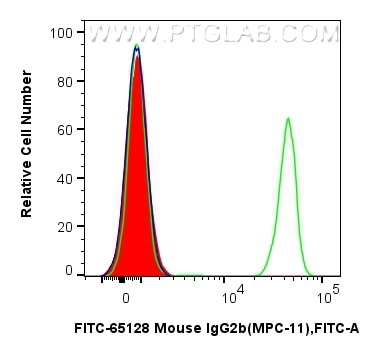Anticorps Monoclonal anti-IgG2b Isotype Control
IgG2b Isotype Control Monoclonal Antibody for FC
Hôte / Isotype
Mouse / IgG2b, kappa
Réactivité testée
n/a
Applications
IF, FC
Conjugaison
FITC Plus Fluorescent Dye
CloneNo.
MPC-11
N° de cat : FITC-65128
Synonymes
Galerie de données de validation
Applications testées
| Résultats positifs en cytométrie | CMSP humaines, |
Dilution recommandée
| Application | Dilution |
|---|---|
| This reagent has been tested for flow cytometric analysis. It is recommended that this reagent should be titrated in each testing system to obtain optimal results. | |
| Sample-dependent, check data in validation data gallery | |
Applications publiées
| IF | See 1 publications below |
Informations sur le produit
FITC-65128 cible IgG2b Isotype Control dans les applications de IF, FC et montre une réactivité avec des échantillons n/a
| Réactivité | n/a |
| Hôte / Isotype | Mouse / IgG2b, kappa |
| Clonalité | Monoclonal |
| Type | Anticorps |
| Immunogène | s/o |
| Nom complet | immunoglobulin heavy chain 3 (serum IgG2b) |
| Symbole du gène | IgG2b Isotype Control |
| Identification du gène (NCBI) | 16016 |
| Conjugaison | FITC Plus Fluorescent Dye |
| Excitation/Emission maxima wavelengths | 495 nm / 524 nm |
| Forme | Liquide |
| Méthode de purification | Purification par affinité |
| Tampon de stockage | PBS with 0.09% sodium azide and 0.5% BSA |
| Conditions de stockage | Store at 2-8°C. Avoid exposure to light. Stable for one year after shipment. |
Informations générales
The MPC-11 immunoglobulin is useful as an isotype-matched control. The MPC-11 immunoglobulin has an unknown binding specificity and is used as an isotype control for mouse IgG2b antibodies. This antibody has been quality-tested for flow cytometry as negative control.
Protocole
| Product Specific Protocols | |
|---|---|
| FC protocol for FITC Plus IgG2b Isotype Control antibody FITC-65128 | Download protocol |
| Standard Protocols | |
|---|---|
| Click here to view our Standard Protocols |


